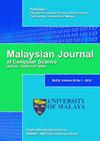EXPLAINING PHYSIOLOGICAL AFFECT RECOGNITION WITH OPTIMIZED ENSEMBLES OF CLUSTERED EXPLAINABLE MODELS
IF 1.2
4区 计算机科学
Q4 COMPUTER SCIENCE, ARTIFICIAL INTELLIGENCE
引用次数: 0
Abstract
Affect recognition tasks involving physiological signals are difficult to generalize across a large population due to low signal-to-noise ratio and limited data availability. In addition, the use of deep learning models makes it difficult to determine the cause-and-effect between physiological affect and labeled affect. This work addresses the following issues: uneven distribution and noisy data were addressed using K-Means-SMOTE and Fuzzy ART (FA). The clustered hyper-rectangles were extracted from the FA topology and fitted to an Explainable Boosting Machines ensemble using the Easy Ensemble strategy. The hyper parameters of the overall methodology were tuned using genetic algorithms for improved generalization. The proposed method was tested using three publicly available affect recognition datasets: DEAP, DREAMER, and AMIGOS. Step-by-step benchmarks showed that combining techniques achieved good generalization and generated explainable information correlating physiological features to affective labels.用聚类可解释模型的优化集合解释生理影响识别
由于低信噪比和有限的数据可用性,涉及生理信号的影响识别任务难以在大群体中推广。此外,深度学习模型的使用使得很难确定生理影响和标记影响之间的因果关系。这项工作解决了以下问题:使用K-Means-SMOTE和模糊ART (FA)解决了数据分布不均匀和噪声问题。从FA拓扑中提取聚类超矩形,并使用Easy ensemble策略拟合到一个Explainable Boosting Machines集成中。采用遗传算法对整体方法的超参数进行了调整,以提高泛化效果。使用三个公开可用的情感识别数据集:DEAP、dream和AMIGOS对所提出的方法进行了测试。一步一步的基准测试表明,组合技术取得了良好的泛化效果,并产生了将生理特征与情感标签相关联的可解释信息。
本文章由计算机程序翻译,如有差异,请以英文原文为准。
求助全文
约1分钟内获得全文
求助全文
来源期刊

Malaysian Journal of Computer Science
COMPUTER SCIENCE, ARTIFICIAL INTELLIGENCE-COMPUTER SCIENCE, THEORY & METHODS
CiteScore
2.20
自引率
33.30%
发文量
35
审稿时长
7.5 months
期刊介绍:
The Malaysian Journal of Computer Science (ISSN 0127-9084) is published four times a year in January, April, July and October by the Faculty of Computer Science and Information Technology, University of Malaya, since 1985. Over the years, the journal has gained popularity and the number of paper submissions has increased steadily. The rigorous reviews from the referees have helped in ensuring that the high standard of the journal is maintained. The objectives are to promote exchange of information and knowledge in research work, new inventions/developments of Computer Science and on the use of Information Technology towards the structuring of an information-rich society and to assist the academic staff from local and foreign universities, business and industrial sectors, government departments and academic institutions on publishing research results and studies in Computer Science and Information Technology through a scholarly publication. The journal is being indexed and abstracted by Clarivate Analytics'' Web of Science and Elsevier''s Scopus
 求助内容:
求助内容: 应助结果提醒方式:
应助结果提醒方式:


